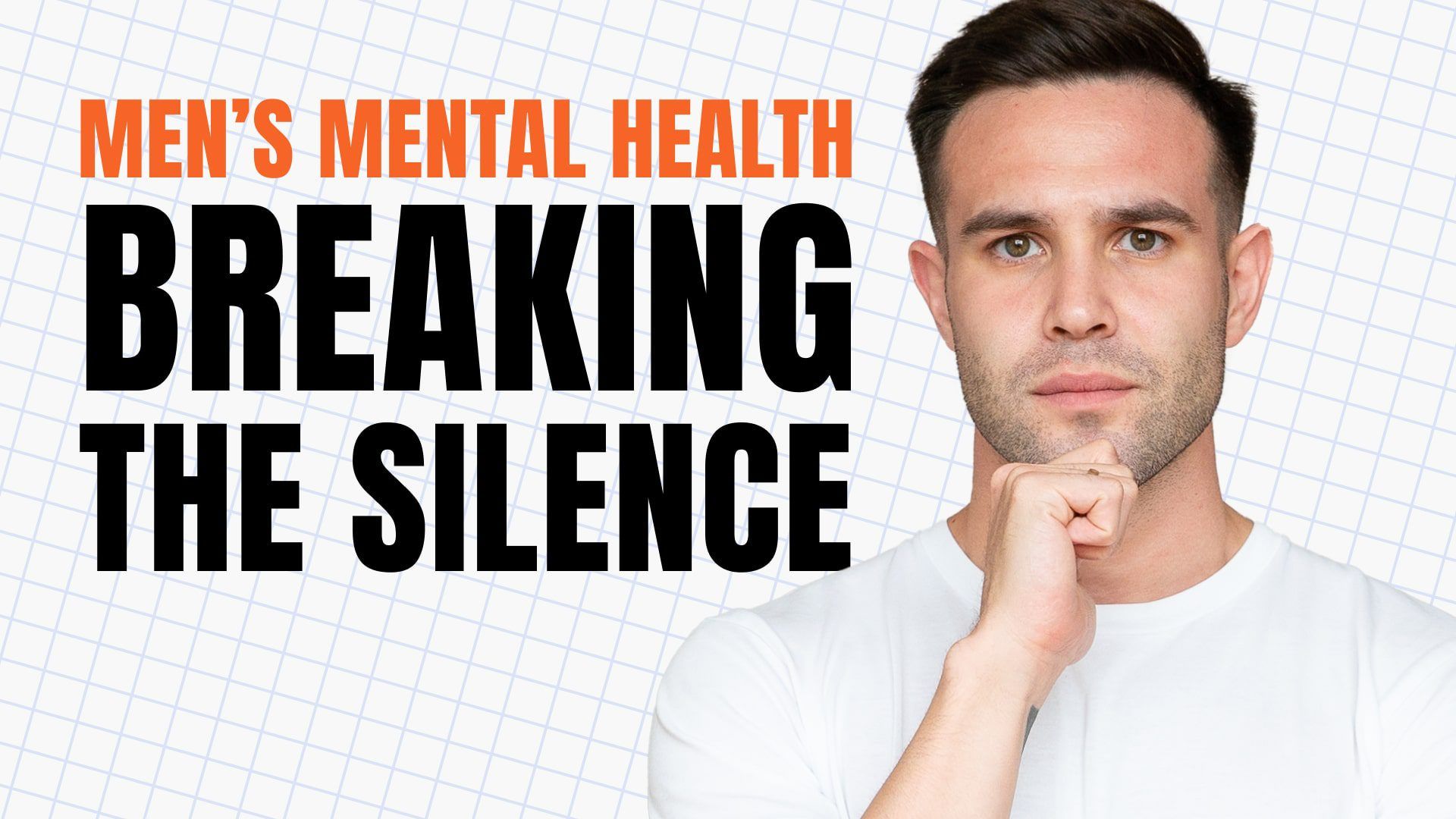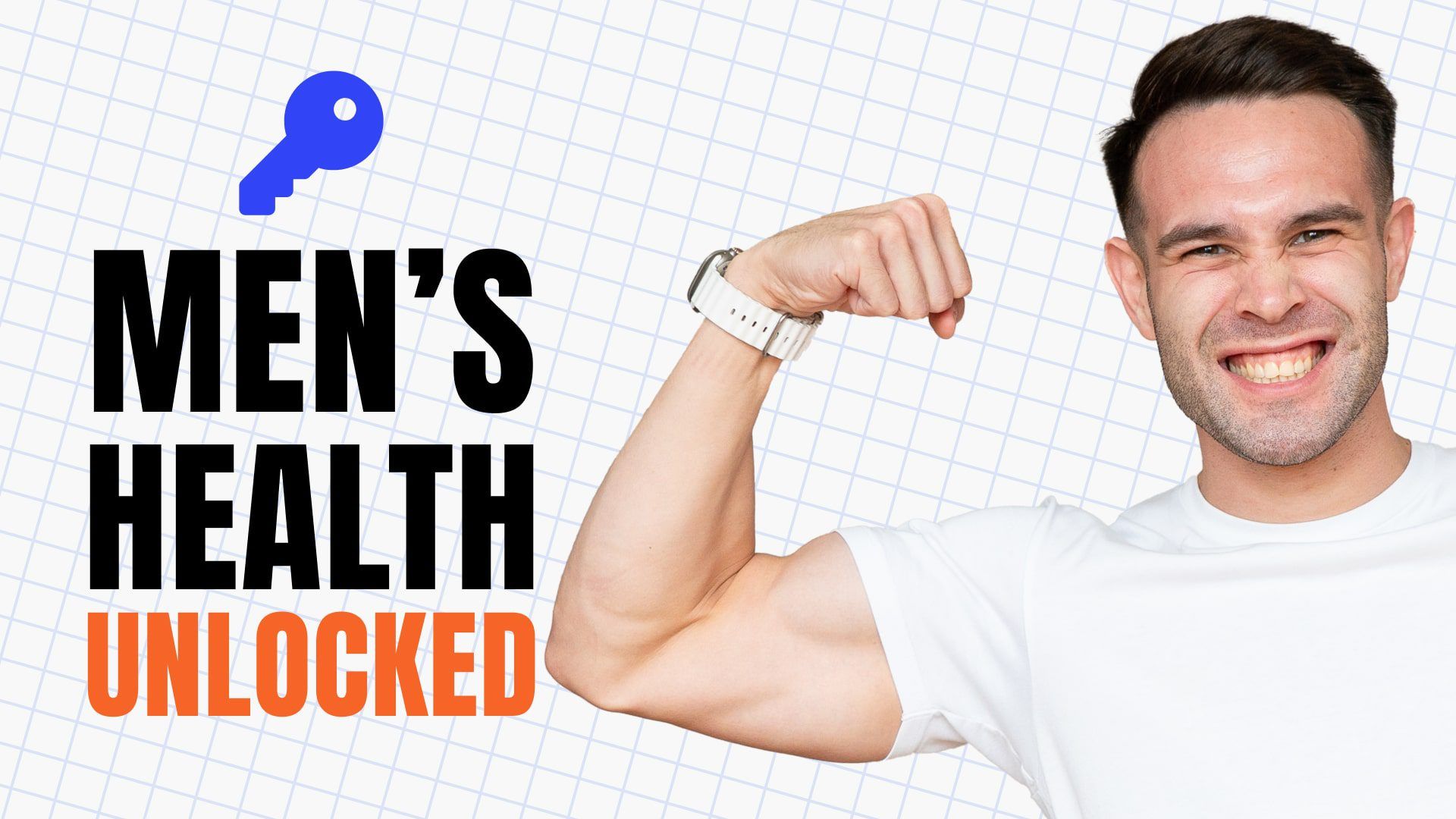Men’s Health Across the Decades: A Lifelong Strategy for Longevity and Vitality

Table of contents
In this article, you will learn…
Maintaining health and vitality throughout life requires adapting your habits and strategies as you age. Each decade brings new challenges and opportunities, and understanding how to navigate these changes is key to long-term well-being.
This guide will take you through each stage of life, offering specific advice on fitness, nutrition, mental health, and preventive care tailored to the unique needs of each decade. By making the right choices at the right times, you can build a strong foundation for a healthier, longer life.
Whether you’re in your 20s or 60s, this article will help you identify the key health priorities for your age group and provide actionable steps to keep you feeling your best.
Don’t like to read? Watch the video
Key Takeaways:
- Adapting your fitness routine to each life stage is crucial for maintaining muscle mass, joint health, and overall physical well-being.
- Nutrition needs change as you age, and adjusting your diet to include more nutrient-dense foods helps support heart health, bone density, and energy levels.
- Regular health screenings become increasingly important with age, allowing for early detection and prevention of potential health issues.
- Mental health and stress management practices are essential at every stage of life, contributing to emotional resilience and quality of life.
- Maintaining an active lifestyle and balanced diet supports long-term health, helping to prevent chronic diseases and promote longevity.
Your 20s: Building a Strong Foundation
Fitness and Physical Activity
Your 20s are the perfect time to establish a solid fitness routine that will benefit you for years to come. During this decade, your body is at its peak in terms of muscle mass and recovery ability, making it an ideal time to focus on building strength and cardiovascular fitness.
Key Activities:
- Strength Training: Incorporating resistance exercises such as weightlifting or bodyweight workouts can help you build muscle and increase metabolic rate.
- Cardiovascular Fitness: Activities like running, cycling, and swimming are excellent for improving heart health and endurance.
- HIIT (High-Intensity Interval Training): This form of exercise is particularly effective in your 20s, combining bursts of intense activity with short recovery periods to maximize calorie burn and cardiovascular benefits.
Establishing a regular exercise routine in your 20s not only helps you stay fit but also sets the stage for a healthier lifestyle in the decades to come.
Nutrition and Diet
Nutrition plays a critical role in supporting your physical activities and overall health during your 20s. This is the time to build a balanced diet that fuels your body and promotes long-term wellness.
Key Considerations:
- Protein Intake: Essential for muscle repair and growth, especially if you’re engaging in regular strength training. Aim to include lean proteins such as chicken, fish, tofu, and legumes in your diet.
- Healthy Fats: Incorporate sources of healthy fats like avocados, nuts, seeds, and olive oil to support brain health and hormone production.
- Complex Carbohydrates: Whole grains, fruits, and vegetables provide the necessary energy for your active lifestyle and are rich in essential vitamins and minerals.
Avoid the temptation of fast food and excessive alcohol, which can derail your health goals. Instead, focus on developing healthy eating habits that will benefit you for life.
Your 30s: Maintaining Momentum and Managing Stress
Fitness and Physical Activity
As you transition into your 30s, maintaining the muscle mass and cardiovascular fitness you built in your 20s becomes essential. However, it’s also important to start incorporating exercises that promote flexibility and mobility, as these can help prevent injuries and maintain joint health.
Key Activities:
- Consistent Strength Training: Continue with regular resistance exercises, but consider adding more functional movements that mimic everyday activities.
- Flexibility and Mobility: Incorporate yoga, Pilates, or dedicated stretching routines to improve flexibility and prevent injuries.
- Cardiovascular Exercises: Maintain a regular cardio routine, but consider incorporating lower-impact activities such as cycling or swimming to protect your joints.
In your 30s, balancing your fitness routine with your growing responsibilities is key. Aim for consistency, even if it means shorter workouts due to a busier schedule.
Nutrition and Diet
Your metabolism may start to slow down in your 30s, making it important to adjust your diet accordingly. Focus on nutrient-dense foods that provide sustained energy and support overall health.
Key Considerations:
- Portion Control: As your metabolism changes, it’s important to monitor portion sizes to avoid unintentional weight gain.
- Nutrient-Dense Foods: Prioritize foods that are high in nutrients but lower in calories, such as leafy greens, lean proteins, and whole grains.
- Hydration: Staying well-hydrated is essential for overall health. Aim to drink plenty of water throughout the day, especially if you’re active.
By making mindful choices about what you eat, you can maintain your energy levels and prevent weight gain as you navigate the demands of your 30s.
Your 40s: Balancing Health and Busy Life
Fitness and Physical Activity
In your 40s, maintaining your fitness becomes more about balancing strength, flexibility, and joint health. This decade often brings increased responsibilities at work and home, making it crucial to integrate exercise into your routine in a sustainable way.
Key Activities:
- Low-Impact Cardio: Activities such as brisk walking, swimming, or cycling can help you maintain cardiovascular health while reducing stress on your joints.
- Resistance Training: Continue strength training, but focus on exercises that protect and strengthen your joints, such as using resistance bands or light weights with higher repetitions.
- Flexibility and Balance: Incorporate exercises like yoga, Pilates, or tai chi to maintain flexibility and improve balance, which becomes increasingly important as you age.
Consistency is key in your 40s, even if your workouts need to be shorter or less intense due to a busy schedule. Aim for at least 30 minutes of moderate activity most days of the week.
Nutrition and Diet
As you move through your 40s, your risk for heart disease and other chronic conditions begins to increase. Adjusting your diet to focus on heart health and weight management becomes increasingly important.
Key Considerations:
- Heart-Healthy Foods: Incorporate more foods that support heart health, such as those rich in omega-3 fatty acids (like salmon and flaxseeds), fiber (like oats and beans), and antioxidants (like berries and leafy greens).
- Reduce Processed Foods: Cut back on processed and sugary foods, which can contribute to weight gain and increase the risk of heart disease.
- Monitor Cholesterol and Blood Pressure: Regularly check your cholesterol levels and blood pressure, and adjust your diet as needed to keep these numbers in a healthy range.
By focusing on a diet that supports heart health and managing your caloric intake, you can prevent weight gain and reduce the risk of chronic disease as you age.
Your 50s: Staying Strong and Preventing Disease
Fitness and Physical Activity
In your 50s, the focus of your fitness routine should be on maintaining strength and mobility, while also supporting bone health. This is the time to make sure your exercise routine is sustainable and gentle on your body.
Key Activities:
- Weight-Bearing Exercises: Engage in activities like walking, hiking, and weight training to support bone density and prevent osteoporosis.
- Swimming and Water Aerobics: These low-impact activities are excellent for maintaining cardiovascular health without putting stress on your joints.
- Flexibility and Mobility: Continue to prioritize stretching, yoga, or Pilates to maintain flexibility and prevent stiffness.
Maintaining an active lifestyle in your 50s helps preserve muscle mass, supports bone health, and reduces the risk of chronic diseases.
Nutrition and Diet
As you enter your 50s, it’s crucial to adjust your diet to support bone health and prevent age-related conditions such as heart disease and osteoporosis.
Key Considerations:
- Calcium and Vitamin D: Ensure you’re getting enough calcium and vitamin D to support bone health. This can be achieved through diet (dairy, fortified foods, leafy greens) or supplements if necessary.
- Limit Sodium: Reducing sodium intake can help manage blood pressure and reduce the risk of heart disease.
- Balanced Diet: Continue to eat a balanced diet rich in fruits, vegetables, lean proteins, and whole grains to maintain overall health and vitality.
By focusing on these nutritional needs, you can support your body’s changing requirements and reduce the risk of developing chronic conditions in your 50s.
Your 60s and Beyond: Aging Gracefully and Maintaining Independence
Fitness and Physical Activity
In your 60s and beyond, the goal is to maintain mobility, balance, and strength to preserve your independence and quality of life. At this stage, it’s important to focus on exercises that promote overall well-being without putting undue stress on your body.
Key Activities:
- Walking and Low-Impact Cardio: Regular walking or other low-impact activities like cycling or water aerobics can help maintain cardiovascular health and support joint function.
- Balance Exercises: Incorporate balance exercises such as tai chi, standing on one leg, or using balance boards to prevent falls and maintain stability.
- Gentle Strength Training: Continue to engage in strength training using lighter weights or resistance bands to maintain muscle mass and support bone health.
Regular physical activity in your 60s and beyond is essential for maintaining mobility, preventing falls, and ensuring you can continue to enjoy an active lifestyle.
Nutrition and Diet
As you age, your nutritional needs continue to evolve. Ensuring you get enough nutrients while managing calorie intake becomes increasingly important to prevent malnutrition and support overall health.
Key Considerations:
- Nutrient-Dense Foods: Focus on nutrient-dense foods that provide vitamins, minerals, and antioxidants without excessive calories. These include colorful fruits and vegetables, lean proteins, and whole grains.
- Adequate Protein Intake: Ensure you’re getting enough protein to maintain muscle mass and strength. This can include sources like eggs, lean meats, dairy, and legumes.
- Monitor Portion Sizes: As metabolism slows, it’s important to watch portion sizes to avoid unwanted weight gain while still meeting your nutritional needs.
Maintaining a balanced diet that supports your body’s needs is crucial for preserving health and vitality in your 60s and beyond.
Frequently Asked Questions
How can I establish a long-term fitness routine that I’ll stick with?
Establishing a long-term fitness routine starts with setting realistic goals and finding activities you enjoy. Start small with activities like walking, swimming, or light strength training, and gradually increase the intensity as your fitness improves.
Consistency is key, so schedule regular workout times that fit into your daily routine. Tracking your progress and celebrating milestones can keep you motivated. It’s also helpful to vary your workouts to prevent boredom and to find a workout buddy or join a class for added accountability.
What are the most important components of a balanced diet?
A balanced diet includes a variety of nutrients that support overall health. The key components are:
- Protein: Essential for muscle repair and growth, found in lean meats, fish, eggs, and plant-based sources like beans and tofu.
- Healthy Fats: Important for brain function and hormone production, sourced from nuts, seeds, avocados, and olive oil.
- Complex Carbohydrates: Provide sustained energy, found in whole grains, fruits, and vegetables.
- Vitamins and Minerals: Crucial for immune function and overall health, best obtained from a varied diet rich in colorful fruits and vegetables.
- Hydration: Drinking plenty of water is essential for all bodily functions, so aim to stay hydrated throughout the day.
How can I manage stress effectively in my daily life?
Effective stress management involves a combination of strategies that help you cope with daily challenges.
Start with regular physical activity, which releases endorphins that naturally reduce stress. Mindfulness practices, such as meditation or deep breathing exercises, can help calm your mind and focus on the present.
Time management and prioritizing tasks can reduce feelings of being overwhelmed. Additionally, maintaining a healthy work-life balance and ensuring you have time for relaxation and hobbies can significantly reduce stress levels.
What should I do if I notice changes in my mental or emotional well-being?
If you notice changes in your mental or emotional well-being, such as persistent sadness, anxiety, or difficulty concentrating, it’s important to take action.
Start by talking to someone you trust about how you’re feeling. Engaging in activities that you enjoy and that relax you can also help improve your mood.
If these feelings persist, consider seeking help from a mental health professional who can provide support and guidance. Early intervention is key to managing mental health effectively.
How important is sleep, and how can I improve my sleep quality?
Sleep is crucial for overall health, as it allows your body to repair and recharge. Poor sleep can lead to a range of health issues, including reduced cognitive function, weakened immunity, and increased stress.
To improve sleep quality, establish a regular sleep schedule by going to bed and waking up at the same time each day, even on weekends.
Create a calming bedtime routine that might include reading, taking a warm bath, or practicing relaxation exercises. Ensure your sleep environment is comfortable, cool, and dark, and avoid screens or heavy meals before bedtime.
What are some ways to maintain muscle mass and strength as I age?
Maintaining muscle mass and strength as you age involves regular resistance training, which can include weightlifting, bodyweight exercises, or resistance band workouts. Incorporate these exercises into your routine at least two to three times a week.
Adequate protein intake is also essential, as it supports muscle repair and growth. Ensure you’re eating enough protein with each meal, and consider supplements if needed, based on your dietary intake.
Staying active in general, including regular physical activity like walking or cycling, can also help preserve muscle mass.
How can I ensure I’m getting all the nutrients my body needs?
To ensure you’re getting all the necessary nutrients, focus on eating a diverse and balanced diet that includes a wide variety of foods. Incorporate plenty of fruits and vegetables, lean proteins, whole grains, and healthy fats into your daily meals.
If you have dietary restrictions or specific health concerns, consider talking to a nutritionist or dietitian who can help you tailor your diet to meet your needs. In some cases, supplements might be necessary to fill any gaps, but it’s best to get most of your nutrients from whole foods.
What role does hydration play in overall health, and how can I ensure I’m drinking enough water?
Hydration is vital for maintaining overall health, as water is involved in nearly every bodily function, from regulating temperature to aiding digestion and circulation. Dehydration can lead to fatigue, headaches, and reduced cognitive function.
To ensure you’re drinking enough water, aim for about 8 glasses (or around 2 liters) per day, but this can vary depending on your activity level, climate, and individual needs. Carrying a water bottle with you and setting reminders to drink water throughout the day can help you stay hydrated.
Additionally, consuming water-rich foods like fruits and vegetables can contribute to your daily hydration needs.
How can I build and maintain a support network for my health and well-being?
Building and maintaining a support network is crucial for both mental and physical health. Start by connecting with friends, family, and colleagues who share your health goals or interests.
Joining groups or clubs, whether focused on fitness, hobbies, or social activities, can also provide a sense of community and accountability. Regularly communicating with your support network, sharing your goals, and encouraging each other can help keep you motivated.
Don’t hesitate to seek professional support from healthcare providers, nutritionists, or fitness coaches when needed—they can offer valuable guidance and help you stay on track.
What preventive health measures should I prioritize to ensure long-term health?
Prioritizing preventive health measures is key to maintaining long-term health. Regular health check-ups are essential, as they allow for early detection of potential issues.
Key screenings include blood pressure, cholesterol levels, diabetes testing, and cancer screenings appropriate for your age and risk factors.
Staying up to date with vaccinations and maintaining a healthy lifestyle through balanced nutrition, regular exercise, and stress management are also crucial. Additionally, focusing on mental health and seeking help when needed can prevent the development of more serious conditions.
Conclusion and Summary
Maintaining health and vitality across the decades requires a proactive and adaptive approach. By understanding the specific needs of each life stage, you can make informed decisions about your fitness, nutrition, and overall well-being.
Starting with a strong foundation in your 20s and making adjustments as you age will help you stay healthy, active, and independent well into your later years.
Remember, it’s never too late to start taking care of your health. Whether you’re in your 20s or your 60s, there are steps you can take today to improve your quality of life and ensure longevity. Prioritize regular check-ups, stay active, eat a balanced diet, and don’t forget to nurture your mental health along the way.
If you have any questions or need further guidance on how to tailor your health strategies to your current life stage, don’t hesitate to reach out. Visit my blog and social media channels for more tips, tools, and resources designed to help you live your best life at any age.
Works Cited, Relevant Links, and Studies
- Centers for Disease Control and Prevention. (2019). The Benefits of Physical Activity.
- Harvard Health Publishing. (2018). Exercise and aging: Can you walk away from Father Time? Harvard Medical School.
- National Institute on Aging. (2021). Eating Well as You Get Older.
- Mayo Clinic. (2020). Men’s health: Prevent the top threats.
- American Heart Association. (2019). Healthy Eating in Your 30s, 40s, and 50s.
- World Health Organization. (2018). Physical activity and older adults.
- National Osteoporosis Foundation. (2020). Osteoporosis and Men.
- U.S. Department of Health and Human Services. (2020). Dietary Guidelines for Americans 2020-2025.
This is a personal blog. I am not a doctor, fitness coach, nutritionist, or trained health professional. The information I share is based on my personal experience, self-research, and insights from working with health and wellness professionals. My content is for informational and entertainment purposes only and is not intended as health advice.
Always consult with your healthcare provider before making any significant changes to your health routines or treatments. I am not liable for any actions taken based on this information.
With that said, your well-being is my top priority. Stay healthy and take care!
Credits and Team















Leave a Reply